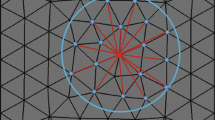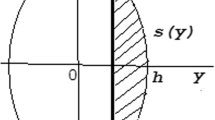Abstract
The expanding ring test of Grady and Benson (1983) is taken as a convenient yet challenging validation problem for assessing the fidelity of cohesive models in situations involving ductile dynamical fracture. Attention has been restricted to 1100-0 aluminum samples. Fracture has been modelled by recourse to an irreversible cohesive law embedded into cohesive elements. The finite element model is three-dimensional and fully Lagrangian. In order to limit the extent of deformation-induced distortion, we resort to continuous adaptive remeshing. The cohesive behavior of the material is assumed to be rate independent and, consequently, all rate effects predicted by the calculations are due to inertia and the rate dependency in plastic deformation. The numerical simulations are revealed to be highly predictive of a number of observed features, including: the number of dominant and arrested necks; the fragmentation patterns; the dependence of the number of fragments and the fracture strain on the expansion speed; and the distribution of fragment sizes at fixed expansion speed.
Similar content being viewed by others
References
Altynova, M., Hu, X.Y. and Daehn, G.S. (1996). Increased ductility in high-velocity electromagnetic ring expansion. Metallurgical and Materials Transactions A 27(7), 1837–1844.
Barenblatt, G.I. (1962). The mathematical theory of equilibrium of cracks in brittle fracture. Advances in Applied Mechanics 7, 55–129.
Beltz, G.E. and Rice, J.R. (1991). Book chapter: Dislocation nucleation versus cleavage decohesion at crack tips. Modeling the Deformation of Crystalline Solids: Physical Theory, Application and Experimental Comparisons (Edited by T.C. Lowe, A.D. Rollett, P.S. Follansbee and G.S. Daehn), Warrendale, PA, 457–480. TSM-AIME.
Belytschko, T. (1983). An overview of semidiscretization and time integration procedures. Computational Methods for Transient Analysis (Edited by T. Belytschko and T.J.R. Hughes), North Holland, 1–65.
Camacho, G.T. and Ortiz, M. (1996). Computational modelling of impact damage in brittle materials. International Journal of Solids and Structures, 33(20–22), 2899–2938.
Camacho, G.T. and Ortiz, M. (1997). Adaptive Lagrangian modelling of ballistic penetration of metallic targets. Computer Methods in Applied Mechanics and Engineering 142, 269–301.
Carpinteri, A. (1986). Mechanical Damage and Crack Growth in Concrete. Martinus Nijhoff, Dordrecht, The Netherlands.
Chen, G. and Ravichandran, W.N. (1994). Dynamic compressive behavior of ceramics under lateral confinement. Journal de Physique IV 4, 177–182.
Chen, G. and Ravichandran, W.N. (1996). Static and dynamic compressive behavior of aluminum nitride under moderate confinement. Journal of the American Ceramic Society 79, 579–584.
Cuitiño, A.M. and Ortiz, M. (1992). A material-independent method for extending stress update algorithms from small-strain plasticity to finite plasticity with multiplicative kinematics. Engineering Computations 9, 437–451.
De-Andrés, A., Pérez, J.L. and Ortiz, M. (1999). Elastoplastic finite element analysis of three-dimensional fatigue crack growth in aluminum shafts to axial loading. International Journal of Solids and Structures 36(15) 2231–2258.
Dugdale, D.S. (1960). Yielding of steel sheets containing slits. Journal of the Mechanics and Physics of Solids 8, 100–104.
Fressengeas, C. and Molinari, A. (1985a). Inertia and thermal effects on the localization of plastic flow. Acta Metallurgica 33, 387–396.
Fressengeas, C. and Molinari, A. (1985b). Localization criteria for plastic deformation of simple traction. Journal de Physique, Colloque C5 46(C5), 121–125.
Fressengeas, C. and Molinari, A. (1989). Tensile instability at high strain rate-inertial and multiaxial effects. Institute of Physics Conference Series 102, 57–64.
Fressengeas, C. and Molinari, A. (1994). Fragmentation of rapidly stretching sheets. European Journal of Mechanics, A/Solids 13(2), 251–268.
Gourdin, W.H. (1989). Analysis and assessment of electromagnetic ring expansion as a high-strain rate test. Journal of Applied Physics 65(2), 411–422.
Gourdin, W.H. and Lassila, D.H. (1991). Flow stress of OFE copper at strain rates from 10−4 to 104 s−1-grainsize effects and comparison to the mechanical threshold stress model. Acta Metallurgica et Materialia 39(10), 2337–2348.
Grady, D.E. (1981). Fragmentation of solids under impulse stress loading. Journal of geophysical Research 86(B2), 1047.
Grady, D.E. and Benson, D.A. (1983). Fragmentation of metal rings by electromagnetic loading. Experimental Mechanics 23, 393–400.
Han, J.B. and Tvergaard, V. (1995). Effect of inertia on the necking behavior of ring specimens under rapid radial expansion. European Journal of Mechanics-A Solids 14(2), 287–307.
Hillerborg, A., Modeer, M., Petersson, P.E. and Needleman, A. (1976). Analysis of crack formation and crack growth in concrete by means of fracture mechanics and finite elements. Cement Concrete Research 6, 773–782.
Hu, X.Y. and Daehn, G.S. (1996). Effect of velocity on flow localization in tension. Acta Materialia 44(3), 1021–1033.
Hughes, T.J.R. (1983). Analysis of transient algorithms with particular reference to stability behavior. Computational Methods for Transient Analysis (Edited by T. Belytschko and T.J.R. Hughes), North-Holland, 67–155.
Hughes, T.J.R. (1987). The Finite Element Method: Linear Static and Dynamic Finite Element Analysis. Prentice-Hall, Englewood Cliffs, N.J.
Jeanclaude, V. and Fressengeas, C. (1997). Dynamic necking of rods at high strain rates. Journal de Physique IV, Colloque C3, Supplement au Journal del Physique III, pages 699–704.
Johnson, J.N. (1983). Ductile fracture of rapidly expanding rings. Journal of Applied Mechanics 50, 593–600.
Juanicotena, A. and Llorca, F. (1997). Utility of the ring expansion test in the analysis of different laws of elastoplastic behavior at high strain rates-application to copper and mars-190 steel. Journal de Physique IV 7(C3), 541–546.
Kipp, M.E. and Grady, D.E. (1985). Dynamic fracture growth and interaction in one dimension. Journal of the Mechanics and Physics of Solids 33(4), 399–415.
Knoche, P. and Needleman, A. (1993). The effect of size on the ductility of dynamically loaded tensile bars. European Journal of Mechanics-A Solids 12(4), 585–601.
Krysl, P. and Ortiz, M. (1998). Generation of tetrahedral finite element meshes; variational Delaunay approach. In 7th International Meshing Roundtable, Dearborn, Michigan.
Lubliner, J. (1972). On the thermodynamic foundations of non-linear solid mechanics. International Journal of Non-linear Mechanics 7, 237–254.
Lubliner, J. (1973). On the structure of the rate equations of materials with internal variables. Acta Mechanica 17, 109–119.
Marsden, J.E. and Hughes, T.J.R. (1983). Mathematical foundations of elasticity. Prentice-Hall, Englewood Cliffs, N.J.
Marusich, T.D. and Ortiz, M. (1995). Modelling and simulation of high-speed machining. International Journal for Numerical Methods in Engineering 38, 3675–3694.
Mathur, K.K., Needleman, A. and Tvergaard, V. (1996). Three-dimensional analysis of dynamic ductile crack growth in a thin plate. Journal of the Mechanics and Physics of Solids 44, 439–464.
McClintock, F.A. and Argon, A.S. (1966). Mechanical Behavior of Materials. Addison-Wesley, Reading, Mass.
Mott, N.F. (1947). Fragmentation of shell cases. Proceedings of the Royal Society of London 300, 300–308.
Needleman, A. (1987). A continuum model for void nucleation by inclusion debonding. Journal of Applied Mechanics 54, 525–531.
Needleman, A. (1990). An analysis of decohesion along an imperfect interface. International Journal of Fracture 42, 21–40.
Needleman, A. (1992). Micromechanical modeling of interfacial decohesion. Ultramicroscopy 40, 203–214.
Nemes, J.A. and Eftis, J. (1993). Constitutive modeling of the dynamic fracture of smooth tensile bars. International Journal of Plasticity 9(2), 243–270.
Nordson, F.I. (1965). A unit for testing materials at high strain rates. Experimental Mechanics 5, 29–32.
Ortiz, M. (1988). Microcrack coalescence and macroscopic crack growth initiation in brittle solids. International Journal of Solids and Structures 24, 231–250.
Ortiz, M. (1996). Computational micromechanics. Computational Mechanics 18, 321–338.
Ortiz, M. and Pandolfi, A. (1999). A class of cohesive elements for the simulation of three-dimensional crack propagation. International Journal for Numerical Methods in Engineering 44(9), 1267–1282.
Ortiz, M. and Suresh, S. (1993). Statistical properties of residual stresses and intergranular fracture in ceramic materials. Journal of Applied Mechanics 60, 77–84.
Pandolfi, A. and Ortiz, M. (1999). Solid modeling aspects of three-dimensional fragmentation. Engineering with Computer 14(4) 287–308.
Planas, J., Elices, M. and Guinea, G.V. (1994). Book chapter: Cohesive cracks as a solution of a class of nonlocal problems. (Edited by Z.P. Bazant). Fracture and Damage in Quasibrittle Structures. Experiment, modeling and Computer analysis E & FN SPON.
Radovitzky, R. and Ortiz, M. (1999a). Error estimation and adaptive meshing in strongly nonlinear dynamic problems. Computer Methods in Applied Mechanics and Engineering.
Radovitzky, R. and Ortiz, M. (1999b). Tetrahedral mesh generation based on node insertion in crystal lattice arrangements and advancing-front-Delaunay triangulation. Computer Methods in Applied Mechanics and Engineering.
Rajendran, A.M. and Fyfe, I.M. (1982). Inertia effects on the ductile failure of thin rings. Journal of Applied Mechanics 49, 31–36.
Rice, J.R. (1968). Mathematical analysis in the mechanics of fracture. Fracture (Edited by Liebowitz), Academic Press, 191–311.
Rice, J.R. (1992). Dislocation nucleation from a crack tip: an analysis based on the Peierls concept. Journal of the Mechanics and Physics of Solids 40, 235–271.
Rose, J.H., Ferrante, J. and Smith, J.R. (1981). Universal binding energy curves for metals and bimetallic interfaces. Physical Review Letters 47(9), 675–678.
Tamhane, A.A., Altynova, M.M. and Daehn, G.S. (1996). Effect of sample size on ductility in electromagnetic ring expansion. Scripta Materialia 34(8), 1345–1350.
Tvergaard, V. and Hutchinson, J.W. (1993). The influence of plasticity on mixed-mode interface toughness. Journal of the Mechanics and Physics of Solids 41, 1119–1135.
Tvergaard, V. and Hutchinson, J.W. (1996a). Effect of strain dependent cohesive zone model on predictions of interface crack growth. Journal de Physique IV 6, 165–172.
Tvergaard, V. and Hutchinson, J.W. (1996b). Effect of strain dependent cohesive zone model on predictions of crack growth resistance. International Journal of Solids and Structures 33, 3297–3308.
Wesenberg, D.L. and Sagartz, M.J. (1977). Dynamic fracture of 6061-T6 aluminum cylinders. Journal Applied Mechanics 44(4), 643–646.
William, K. (1989). Simulation issues of distributed and localized failure computations. Cracking and Damage (Edited by J. Mazars and Z.P. Bazant), Elsevier Science, New York, 363–378.
Winter, R.E. (1979). Measurement of fracture strain at high strain rates. Institute of Physics Conference Ser. 47, 81.
Xu, X.P. and Needleman, A. (1993). Void nucleation by inclusion debonding in a crystal matrix. Modelling and Simulation in Materials Science and Engineering 1, 111–132.
Xu, X.P. and Needleman, A. (1994). Numerical simulations of fast crack growth in brittle solids. Journal of the Mechanics and Physics of Solids 42, 1397–1434.
Xu, X.P. and Needleman, A. (1995). Numerical simulations of dynamic interfacial crack growth allowing for crack growth away from the bond line. International Journal of Fracture 74, 253–275.
Xu, X.P. and Needleman, A. (1996). Numerical simulation of dynamic crack growth along an interface. International Journal of Fracture 74, 289–324.
Author information
Authors and Affiliations
Rights and permissions
About this article
Cite this article
Pandolfi, A., Krysl, P. & Ortiz, M. Finite element simulation of ring expansion and fragmentation: The capturing of length and time scales through cohesive models of fracture. International Journal of Fracture 95, 279–297 (1999). https://doi.org/10.1023/A:1018672922734
Issue Date:
DOI: https://doi.org/10.1023/A:1018672922734




